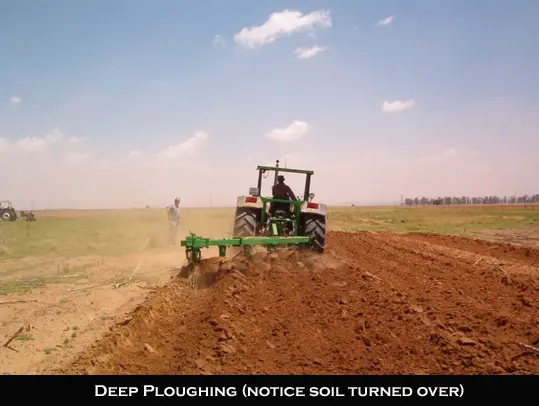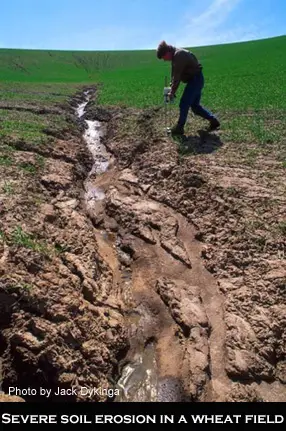
Conservation Tillage Wedge: Steel ploughs (or US plow) were developed during the Industrial Revolution and were lighter and more durable than ploughs made of iron or wood. The mould board (or US moldboard) plough produces a deep furrow and turns the earth over, after the soil has been has sliced by the front shear. Mouldboard ploughing rapidly depletes the organic matter content of soil and promotes erosion; these two problems go hand in hand. As soil is brought to the surface, the root structure of the previous harvest is broken up, and the natural adhesion of soil particles is also lost; though loose soil appears good for plant germination (and it is), this loose soil without cohesion is highly susceptible to erosion, multiplying the rate of erosion by several factors compared to a non-mouldboarded plot.

This increased rate of erosion but deep ploughing will not only outpace the rate of soil genesis but also the replacement rate for organics in the soil, thus depleting the soil more rapidly than normal. Mouldboard ploughing leads to increased soil compaction and loss of pore space within the soil. Soil is a bit like a bucket full of balls filled with sand. Each ball represents a cohesive particle of soil, and when stacked the balls leave a great deal of air space, required for healthy root growth and proper drainage. Mouldboarding so disturbs the soil that it breaks these balls and releases their contents. When this happens, the much smaller particles that are within the larger particles are released and pore space diminishes, leading to hard compacted soil that floods easily and restricts root growth  Up to one third of the carbon in soil is lost when forests are cleared and turned into croplands that are ploughed each year. Around fifty percent of carbon is lost from the soil if the land was formerly grassland or pasture.
Up to one third of the carbon in soil is lost when forests are cleared and turned into croplands that are ploughed each year. Around fifty percent of carbon is lost from the soil if the land was formerly grassland or pasture.
It is estimated that approximately 55 Giga tonnes (Gt) of carbon has been lost from the 1600 million hectares of cropland around the globe. This soil carbon loss can be reversed by techniques that increase the rate of carbon input into agricultural soils or reduce the rate of carbon loss. Some conservation techniques reduce the period of bare fallow and also plant cover crops to stop erosion and soil loss. Other conservation techniques include tillage practices that reduce aeration of the soil, such as no till, ridge till, or chisel plough planting.
Experiments have shown that it is possible to reverse the loss of soil carbon on croplands with these techniques and to store carbon at an average rate of 0.3-0.6 t/ha-y over a period of several decades. The lower storage rate, if it could be continued for 50 years, would store the 25 GtC required to contribute a wedge if it were applied to all cropland.
Conservation tillage alone had been adopted on 110 million hectares by 1995. The IPCC estimated that a Conservation Tillage Wedge (up to 22-29 GtC) could be filled by management of existing agricultural soils.
